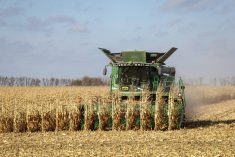Fertility management for soybeans isn’t a one-size-fits-all solution. Fertilizer management decisions are often specific to soils, local growing conditions and factors such as the price of inputs, high soybean prices, as well as other crops in the rotation.
Dr. Gyles Randall of the University of Minnesota recently shared some insights at the Manitoba Agronomists Conference in Winnipeg into what influences soybean fertilizer management in the U.S. Corn Belt, where soybeans generally follow corn in the rotation.
While U.S. rotations are different from Manitoba, where producers are more likely to grow soybeans after wheat or canola, what’s important to bear in mind when making decisions about fertility management in soybeans is the probability of yield response, Randall said as he summarized data from several studies over the past 40 years.
Read Also

Time to be honest about hemp, experts say
Years of hype have given way to a more realistic view of hemp. Farmers and processors say the crop’s future depends on solid agronomy, honesty.
“Is that probability of yield response three times in 20 or is it 15 times in 20?” he says “That makes a difference and when you start looking at lots of pieces of data it gives you that opportunity to say, is this a highly probable response or a low or in-between probability?”
Nitrogen
Soybeans are a legume which fix most of their needed nitrogen (N) from the air, so in areas where soybean production has been long established, such as Minnesota, inoculation of soybean seed is not recommended. But in Manitoba, where soybean production is fairly new, inoculation is necessary until N-fixing rhizobium bacteria populations reach sufficient levels.
Although N fertilizer is not generally recommended for soybeans in the U.S., some studies have shown a response to N fertilizer under certain conditions, such as soils with low organic matter. Studies in northern areas of Minnesota, which had low organic matter soils showed an eight bu./ac. response in soybean yields to applications of 24 lbs. fertilizer N. “In Manitoba as soybeans become more prominent we can’t close our minds to N fertilization as being a part of the tool box for successful yield response,” says Randall.
Phosphorus
Phosphorus fertilization is often considered to be a “non-issue” in the U.S. Corn Belt where soybeans generally follow corn, a crop that requires large amounts of P, the excess of which then remains available to the following soybean crop. Randall presented data from rotation trials that showed high soybean yields cannot be achieved on low P test soils, even when fertilizer P is applied at higher rates.
In the first eight years of the trials, corn was grown continuously; soybeans were added in the ninth year and then rotated with corn every other year for the next three years. Over the 12 years, P treatments of zero, 50 lbs./ac. and 100 lbs./ac. were applied annually as a broadcast treatment and then one treatment applied 150 lbs./ac. once every three years.
The study found that yield responses in the triennial P applications were comparable to those where 50 lbs. or 100 lbs. of P were applied every year, demonstrating that residual P met the needs of subsequent crops.
The study also determined that broadcasting of P in the previous corn crop gave the greatest probability of high yields in the following soybean crop. Very little seed-placed or starter P fertilizer is used in the U.S. because of concerns about seedling injury and because soybeans following corn in the rotation provide adequate soil test P even in the early spring.
Manitoba soils are generally colder and more alkaline, so P fertilization is necessary, especially during the early stages of plant growth when soil P is not as available and plant roots have not developed sufficiently to access P reserves in the soil.
Seed-placed or side-banded P fertilizer is usually recommended for Manitoba conditions, but application rates are generally low due to the risk of seedling injury in the sensitive soybean crop. This means that in Manitoba rotations which include soybeans and other sensitive crops such as canola, soil P can be depleted over time, and there is a need to look at replacement strategies to maintain the P levels necessary to target optimum yields in either of these sensitive crops.
Iron
The potassium, sulphur and zinc needs of soybeans are generally met by the soil, but iron-deficiency chlorosis has been a recurring problem in Minnesota and is common in high-pH soils. Studies have shown significant yield responses with foliar applications of iron chelate products, as well as promising results from companion seeding a crop like oats, to decrease nitrate levels in the soil, prior to seeding soybeans, but neither have been widely adopted as production practices. The planting of iron-tolerant or -resistant varieties remains the favoured way to avoid iron deficiencies.
Mineral nutrition effects of glyphosate
There has also been some discussion in published literature about the role of glyphosate-resistant traits on the mineral nutrition of glyphosate-tolerant crops, including soybeans.
Some studies have suggested that glyphosate immobilizes critical micronutrients such as iron, manganese and zinc that help plants resist disease. Randall quoted from a paper recently published in the Journal of Agri Food Chemistry, the authors of which had conducted an exhaustive review of literature available on this topic.
The paper concludes: “Although there is conflicting literature on the effects of glyphosate on mineral nutrition in glyphosate-resistant (GR) crops most of the literature indicates the mineral nutrition of GR crops or crop diseases are not affected by either the GR trait or by application of glyphosate. Yield data of GR crops do not support the hypothesis that there are substantive mineral nutrition or disease problems that are specific to GR crops.”
Again, says Randall, it’s about probability. “Some pieces of information indicate there might be a micronutrient effect of glyphosate but the wide body of knowledge says that there is no effect, so as we look at the probability of this, the probability would say, ‘don’t worry about it.’”
Science may agree to disagree about some aspects of soybean production, but one thing is certain; fertilizer management is critical.














